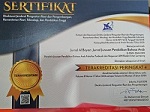Contemporary Arabic Idiomatic Expressions and Methods of Teaching l Al-Ta’birat al-Ishthilahiyyah al-‘Arabiyyah al-Mu‘asharah wa Thara’iqu Ta’limiha
Abstract
Keywords
Full Text:
PDFReferences
Abbas, Al-Susah. al-Arabiyah al-Fusha al-Mua’shirah wa Ushuluha al-Turastiyah. al-Qahirah: Daar Gharib, 2002.
Abdelali, Ahmed. “QADI : Arabic Dialect Identification in the Wild.” Proceedings Ofthe Sixth Arabic Natural Language Processing Workshop, 2021, 1–10.
Ahmad Almaaytah, Shahab. “Translation of Idiomatic Expressions from Arabic into English Using AI (Artificial Intelligence).” Journal of Positive School Psychology 6, no. 4 (2022): 8839–8846.
Al-Azm, Abdul Ghani Abu. Mu’jam al-Ghani. Bi Mauqi’ Mu’jam al-Ma’ani Arabiy Arabiy wa Mauqi’ al-Maktabah al-Syamilah, 2021
AlEnezi. Dalal R. and Tarek A. Alkhaleefah, “Investigating Saudi Student Translators’ Difficulties and Strategies in Translating English Culture-Bound and Idiomatic Expressions: A Quantitative Study,” English Language Teaching 16, no. 2 (2023): 98–119, https://doi.org/https://www.iasj.net/iasj/article/266084.
Aloudah, Nouf M. “Qualitative Research in the Arabic Language. When Should Translations to English Occur? A Literature Review.” Exploratory Research in Clinical and Social Pharmacy 6, (2022): 100153. https://doi.org/10.1016/j.rcsop.2022.100153.
Arikunto, Suharsimi. Prosedur Penelitian: Suatu Pendekatan Praktik. Jakarta: PT. Rineta Cipta, 2006.
Bahruddin, Uril. “Musykilah Ta’limiyah al-Lughah al-‘Arabiyah bi Jami’iyah Maulana Malik Ibrahim Malang wa al-Hulul al-Muqtarahah laha.” Lingua 12, no. 1 (2017).
Darwish, Kareem, Nizar Habash, Mourad Abbas, Hend Al-Khalifa, Husein . Al-Natsheh, Houda Bouamor and Karim Bouzoubaa. “A Panoramic Survey of Natural Language Processing in the Arab World.” Communications of The ACM 64, no. 4 (2021): 72–81.
Daud, Muhammad Muhammad. Mu’jam al-Ta’bir al-Ishthilahiy fi al-Arabiyah al-Mu’ashirah. Daar Gharib, 2003. http://archive.org/details/moajam_attaabr.
Eldeeb, Muftah B. “Euphemism in Arabic Language: The Case with Death Expressions.” Journal of Educational, 2022, 564–568.
Fahrurrozi, Aziz. “Pembelajaran Bahasa Arab : Problematika Dan Solusinya.” Arabiyat : Jurnal Pendidikan Bahasa Arab Dan Kebahasaaraban 1, no. 2 (2014): 161–180. https://doi.org/10.15408/a.v1i2.1137.
Fayd, Wafa Kamil. “Ba’dhu Suar al-Ta’birat al-Ishthilahiyah fi al-Arabiyah al-Mu’ashirah.” Majallah Majma’ al-Lughah al-Arabiyah Dimasqa Al-Mujallad (78) al-Juz (4) (t.t.).
Guellil, Imane, Houda Saadane, Faical Azouaou, Billel Geuni and Damien Nouvel. “Arabic Natural Language Processing : An Overview.” Journal of King Saud University - Computer and Information Sciences 33, no. 5 (2021): 497–507. https://doi.org/10.1016/j.jksuci.2019.02.006.
Hadi, Rana Dahkel and Sarmad Adil Sahib Harbi, “Towards A Structural Linguistic Theory: An Introduction to the Statement of the Classical Arabic System and Its Systems,” Basic Education College Magazine for Educational and Humanities Sciences 15, no. 59 (2023): 505–520, https://doi.org/https://www.iasj.net/iasj/article/266084.
Halabi, Ahmad To’amah. Ta’lim al-Lughah al-‘Arabiyyah li Ghoiri al-Nathiqin biha al-Mu’awiqat wa al-Hulula. Riyadh: Markaz Almalik Abdullah bin Abdul Aziz al-Dauli li Khidmat al-Lughah al-‘Arabiyyah, 1437
Hamid, Abdullah bin. Kitab al-Ta’bir lil Mustawa al-Awwal min Silsilati Ta’lim al-Lughah al-Arabiyah li al-Nathiqina bighairiha. al-Riyadh: Thob’ah Jamiah al-Imam Muhammad bin Su’ud al-Islamiyah, 1987.
Ibrahim, Musthofa.,dkk.. al-Mu’jam al-Washith. Mesir: Maktabah al-Ilmiyyah, 2014.
Jabran, Mas’ud. al- Raid: Mu’jam Lughawiy Ashriy Ruttibat Mufradatuhu Wafqan li Hurufiha al-Ula. Bairut: Daarul Alam, 1964. https://books.google.co.id/books?id=h8PGnQEACAAJ.
J. Moelong, Lexy. Metodologi Penelitian Kualitatif, Bandung: Remaja Rosda Karya, 2001.
Jihad M. Hamdan and Dina Hammouri. “The Pragmatic Functions of the Idiomatic Expression Yalla in Jordanian Spoken Arabic.” Psycholinguistics 31, no. 2 (2022): 137–160. https://doi.org/10.31470/2309-1797-2022-31-2-137-160.
Kholathi, Muhammad Muza’al. “Al-Lughoh al-‘Arabiyah al-Mu’ashirah baina al-Thumuh wal Tahaddiy.” Journal of Education College Wasit University 1, no. 12 (2012). https://doi.org/10.31185/eduj.Vol1.Iss12.423.
Khoshaba, Lubna M. “Problems of Translating English Idiomatic Expressions into Arabic.” Qalaai Zanists Journal 6, no. 4 (2021): 1001–1012. https://doi.org/10.25212/lfu.qzj.6.4.37.
Koentjorodiningrat. Metode-Metode Penelitian Masyarakat. Jakarta: Gramedia, 1991.
Marat, Khodijah. “Al-Ta’abir al-Ishthilahiyah fi al-Lughoh al-‘Arabiyah Dirasah Washfiyah Tahliliyah li Mu’jam al-Ta’bir al-Ishthilahiy fii al-‘Arabiyah al-Mu’ashirah.” Revue internationale de Traduction Moderne 6, no. 9 (2021): 73–82.
Musaad, Majid Mohammed Ali Mabkhut and Adbulrahman Ali Al Towity, “Translation Evaluation of Three Machine Translation Systems, with Special References to Idiomatic Expressions,” Humanities and Educational 29 (2023): 678–708, https://doi.org/https://doi.org/10.55074/hesj.vi29.700.
Naifah, Naifah. “Syuyu’ al-Ta’birat al-Quraniyah wa Wudhuhiha lada al-Tholabah fi Marhalati al-Dukturah bi Jami’ati Maulana Malik Ibrahim al-Islamiyah al-Hukumiyah Malang fi Dhoi al-Dirasati al-Dalaliyati.” Disertasi. Universitas Islam Negeri Maulana Malik Ibrahim. 2021. http://etheses.uin-malang.ac.id/26188/.
Nawa, Amany Binti, dan Muhammad Sobri bin Syarir. “Taqwim Barnamaj Tafauliy fi Ta’lim al-Ta’birat al-Ishthilahiyah fi al-Lughoh al-‘Arabiyah lada al-Darisina al-Nathiqina bighoiriha bistikhdami Barnamaj al-Wasaith al-Muta’adidah.” Majallatu Jami’ati al-Qudsi al-Maftuhah lil Buhuts al-Insaniyah wal Ijtima’iyah 2, no. 36 (2017).
Nurhidayati. “Validity of Paragraph Writing Skills Teaching Materials Based on Qur’ani Idiomatic Patterns.” International Journal Od Social Science and Human Research 05, no. 06 (2022): 2107–2119. https://doi.org/10.47191/ijsshr/v5-i6-14.
Shoufan, Abdulhadi and Sumaya Al-Ameri. “Natural Language Processing for Dialectical Arabic : A Survey.” Proceedings Ofthe Second Workshop on Arabic Natural Language Processing (2015): 36–48.
Suleiman, Dima and Wael Al Etawi. “The Use of Hidden Markov Model in Natural Arabic Language Processing: A Survey.” Procedia Computer Science 113. (2017): 240–247. https://doi.org/10.1016/j.procs.2017.08.363.
Syalalidah, Fadiy Auni Mahmud al-. “al-Ta’abir al-Ishthilahiyah fi Mu’jam ‘al-Tarakib wa al-Ibarat al-Isthilahiyah al-arabiyah al-Qadim minha wal Maulid’ Anamudzajan Dirasah wa Tahlil.” Revue internationale de Traduction Moderne 6, no. 9 (2021): 15–32.
Umar, Ahmad Mukhtar Mu’jam Al-Lughah Al-‘Arabiyah Al-Muashirah, Al-Qohiroh: ‘Alimul Kitab, 2008.
Woodeson, Kanchanokchon, Pangsakorn Limna and Nalin Nga-Fa. “Tudents’ Vocabulary Learning Difficulties and Teachers’ Strategies: A Qualitative Case Study of Ammartpanichnukul School, Krabi in Thailand,” Advance Knowledge for Executives 2, no. 1 (2023): 1–9, https://doi.org/https://ssrn.com/abstract=4393641.
Zayed, Mujahed hossein Tahir, Wan Muhammad Wan Sulong, Salina Husein and Yasir Yahya. “Strategies Used in Arabic – English Translation of Idiomatic Expressions in the Novel Men in the Sun.” Review International Geographical Education 11, no. 9 (2021): 2209–19. https://doi.org/10.48047/rigeo.11.09.193.
DOI: http://dx.doi.org/10.24042/albayan.v15i1.10186
Refbacks
- There are currently no refbacks.
Copyright (c) 2023 Jurnal Al Bayan: Jurnal Jurusan Pendidikan Bahasa Arab
License URL: https://creativecommons.org/licenses/by-sa/4.0
Editorial Office:
Jurnal Al Bayan: Jurnal Jurusan Pendidikan Bahasa Arab, Arabic Education Study Program, Faculty of Education and Teachers Training, Unversitas Islam Negeri Raden Intan Lampung
Jl. Endro Suratmin 1 Sukarame, Bandar Lampung 35131-Indonesia
e-mail: jurnalalbayan@radenintan.ac.id
http://ejournal.radenintan.ac.id/index.php/albayan/index
Jurnal Al Bayan: Jurnal Jurusan Pendidikan Bahasa Arab is licensed under a Creative Commons Attribution-ShareAlike 4.0 International License. p-ISSN 2086-9282 | e-ISSN 2549-1229









